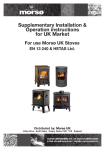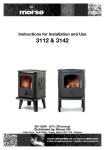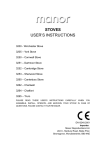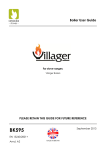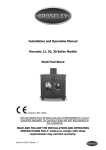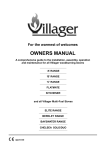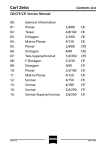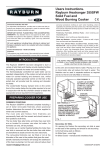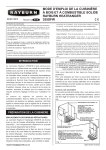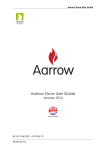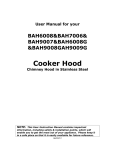Download Morso S10 Specifications
Transcript
Supplementary Installation & Operation instructions for UK Market For use Morsø UK Stoves EN 13 240 & HETAS Ltd. Distributed by: Morsø UK Valley Drive · Swift Valley · Rugby, Warks CV21 1TW · England SUPPLEMENTARY INSTALLATION INSTRUCTIONS FOR USE WITH MORSØ UK STOVES 1430 72 3610 220 7943 162-174 S11-40 76 1440 90 6140 105 7948 156 S11-42 73 1442 90 6148 118 7970 135 S11-43 82 In all cases the installation must comply with current Building Regulations, Local Authority Byelaws and other specifications or regulations as they affect the installation of the stove. It should be noted that the Building Regulations requirements may be met by adopting the relevant recommendations given in British Standards BS 8303, BS EN 15287 and BS 7566 as an alternative means to achieve an equivalent level of performance to that obtained following the guidance given in Approved Document J. 1630 145 7110 140 7990 189 S11-90 96 2110 115 7440 105 8140 165 S50-40 169 2140 140 7442 116 8141 192 S80-90 165 Please note that it is a legal requirement under England and Wales Building Regulations that the installation of the stove is either carried out under Local Authority Building Control approval or is installed by a Competent Person registered with a Government approved Competent Persons Scheme. HETAS Ltd operate such a Scheme and a listing of their Registered Competent Persons can be found on their website at www.hetas.co.uk. 3112 95 7443 109 8142 190 S81-90 77 3142 113 7448 110 8147 204 Ø4 86 PLEASE READ THE INSTRUCTION MANUAL AND THESE SUPPLEMENTARY INSTRUCTIONS CAREFULLY BEFORE INSTALLATION CO Alarms: Building regulations require that when ever a new or replacement fixed solid fuel or wood/biomass appliance is installed in a dwelling a carbon monoxide alarm must be fitted in the same room as the appliance. Further guidance on the installation of the carbon monoxide alarm is available in BS EN 50292:2002 and from the alarm manufacturer’s instructions. Provision of an alarm must not be considered a substitute for either installing the appliance correctly or ensuring regular servicing and maintenance tof the appliance and chimney system. Cast iron Cast iron is a live material. There are no two ovens that are identical. This is partly due to the tolerances of the casting process, partly because the ovens are a work of craftsmanship. Fire Cement Some types of fire cement are caustic and should not be allowed to come into contact with the skin. In case of contact wash immediately with plenty of water and consult manufacturers guidelines. Asbestos Morsø stoves do not contain asbestos. If there is a possibility of disturbing any asbestos in the course of installation then please seek specialist guidance and use appropriate protective equipment. In the UK these stoves have been approved by HETAS Ltd as an intermittent operating appliance for burning wood logs only. It should be noted that it is an offence to burn wood logs in a stove if it is installed within a Smoke Control Area in the UK unless the stove is approved to do so. The nominal heat outputs for the various stoves are as follows: 2 3 Health and Safety Precautions Care must be taken when installing the stove such that the requirements of the Health and Safety at Work Act are met. Handling Adequate facilities must be available for loading, unloading and site handling. Stove weights including packaging Model N° Nominal Heat Output 1410 1412 Nominal Heat Output Net Eff % Gross Eff % Model N° KW Net Eff % Gross Eff % 4,5 76 69,2 7943 7,3 79 71,9 5 74.6 67,9 7948 7,3 79 71,9 1430 4,6 71 64,6 7970 7,3 79 71,9 1440 4,5 76 69,2 7990 7,3 79 71,9 1442 5 74.6 67,9 8140 6,3 80.3 73,3 1630 10,5 74 64,3 8141 6,3 80.3 73,3 KW Model N° Weight Kg Model N° Weight kg Model N° Weight kg Model N° Weight Kg Model N° Weight Kg 2110 9 72 65,5 8142 6,3 80.3 73,3 1410 70 3410 110 7470 108 S10-40 98 Ø6 112 2140 5,6 76 69,2 8147 6,3 80.3 73,3 1412 70 3440 127 7940 152 S11-70 102 Ø8 145 3112 5 81 73,7 S10-40 5 81,3 74 If installation is into an existing chimney then it must be sound and free from cracks or other faults which might allow fumes into the property. Any existing chimney must be clear of obstruction and have been swept clean immediately before installation of the stove. If the stove is fitted in place of an open fire then the chimney should be swept one month after installation to clear any soot falls which may have occurred due to the difference in combustion between the stove and the open fire. If there is no existing chimney then either a prefabricated block chimney in accordance with Building Regulations Approved Document J or a twin walled insulated stainless steel flue to BS 4543 can be used. These chimneys must be fitted in accordance with the manufacturer’s instructions and Building Regulations. A single wall metal fluepipe is suitable for connecting the stove to the chimney but is not suitable for using for the complete chimney. The chimney must have a minimum diameter of 150 mm and its 4 5 3142 5 81 73,7 S10-70 5 81,3 74 3410 6,5 80.1 72,9 S11-40 4 83 75,5 3440 6,5 80.1 72,9 S11-42 4 83 75,5 3610 9,8 74 67,3 S11-43 4 83 75,5 6140 5,9 80.1 72,9 S11-90 4 83 75,5 6148 5,9 80.1 72,9 S50-40 8 78,4 71,3 7110 5,4 75.5 68,7 S80-90 9 76,7 69,7 7440 4,3 82,3 74,9 S81-90 4 88 80,5 7442 4,3 82,3 74,9 Ø4 5,6 81 73,7 7443 4,3 82,3 74,9 Ø6 7,7 75 68,3 7448 4,3 82,3 74,9 Ø8 9,3 75 65,5 7470 4,3 82,3 74,9 7940 7,3 79 71,9 Stove Performance dimension should be not less than the size of the outlet spigot of the stove. Any bend in the chimney or connecting fluepipe should not exceed 45°. 90° bends are not permitted. Combustible material should not be located where the heat dissipating through the walls of fireplaces or flues could ignite it. Therefore when installing the stove in the presence of combustible materials due account must be taken of the guidance on the separation of combustible material given in Building Regulations Approved Document J and also in the stove installation instructions. If it is found that there is excessive draught in the chimney then a draught stabiliser should be fitted. All joints in the connection between the stove and the chimney must be made gastight using the rope gasket provided and if required a suitable sealant. The chimney can be swept through the stove if the stove is connected via the top flue outlet. When installing via the rear flue outlet adequate provision e.g. easily accessible soot door or doors must be provided for sweeping the chimney and connecting fluepipe. It may also be necessary to provide additional sweeping access when fluing through a register plate. Hearth Prefactory Work and Safety Checks There must not be an extractor fan fitted in the same room as the stove as this can cause the stove to emit fumes into the room. The hearth should be able to accommodate the weight of the stove and its chimney if the chimney is not independently supported. The weight of the stove is indicated in the brochure. Chimney The stove should always be installed on a non-combustible hearth of a size and construction that is in accordance with the provisions of the current Building Regulations Approved Document J. NOTE: A chimney height of not less than 4.5 metres measured vertically from the outlet of the stove to the top of the chimney should be satisfactory. Alternatively the calculation procedure given in BS 5854:1980 may be used as the basis for deciding whether a particular chimney design will provide sufficient draught. The clearance distances to combustible material beneath, surrounding or upon the hearth and walls adjacent to the hearth should comply with the guidance on the separation of combustible material given in Building Regulations Approved Document J and also in the stove instructions. If the stove is to be installed on a wooden floor, it must be covered with a non-combustible material at least 12mm thick, in accordance with Building Regulations Approved Document J, to a distance of 30 cm in front of the stove and 15 cm to each side measuring from the door of the combustion chamber. Important Notes Combustion air supply General Before lighting the stove check with the installer that the installation work and commissioning checks described in the installation instructions have been carried out correctly and that the chimney has been swept clean, is sound and free from any obstructions. As part of the stoves’ commissioning and handover the installer should have shown you how to operate the stove correctly. In order for the stove to perform efficiently and safely there should be an adequate air supply into the room in which the stove is installed to provide combustion air. The provision of air supply to the stove must be in accordance with current Building Regulations Approved Document J. An opening window is not appropriate for this purpose. CO Alarm Your installer should have fitted a CO alarm in the same room as the appliance. If the alarm sounds unexpectedly, follow the instructions given under “Warning Note” above. Commissioning and handover Ensure loose parts are fitted in accordance with the stove instruction booklet. On completion of the installation allow a suitable period of time for any fire cement and mortar to dry out, when a small fire may be lit and checked to ensure the smoke and fumes are taken from the stove up the chimney and emitted safely to atmosphere. Do not run at full output for at least 24 hours. On completion of the installation and commissioning ensure that the operating instructions for the stove are left with the customer. Ensure to advise the customer on the correct use of the appliance with the fuels likely to be used on the stove and warn them to use only the recommended fuels for the 6 stove. Advise the user what to do should smoke or fumes be emitted from the stove. The customer should be warned to use a fireguard to BS 8423 in the presence of children, aged and/or infirm persons. Supplementary Operating Instructions for use with Morsø UK stoves PLEASE READ THE INSTRUCTION MANUAL AND THESE SUPPLEMENTARY INSTRUCTIONS CAREFULLY BEFORE USING THE STOVE. Warning Note Properly installed, operated and maintained this stove will not emit fumes into the dwelling. Occasional fumes from de ashing and re fuelling may occur. However, persistent fume emission is potentially dangerous and must not be tolerated. If fume emission does persist, then the following immediate action should be taken: (a) (b) (c) (d) Open doors and windows to ventilate room. Let the fire go out or eject and safely dispose of fuel from the appliance. Check for flue or chimney blockage and clean if required. Do not attempt to relight the fire until the cause of the fume emission has been identi and corrected. If necessary seek expert advice. fied The most common cause of fume emission is flueway or chimney blockage. For your own safety these must be kept clean at all times. Use of fireguard When using the stove in situations where children, aged and/or infirm persons are present a fireguard must be used to prevent accidental contact with the stove. The fireguard should be manufactured in accordance with BS8423:2002. Chimney cleaning 7 The chimney should be swept at least once a year for smokeless fuels and a minimum of twice a year for wood and other fuels. It is important that the flue connection, any appliance baffles or throat plates and the chimney are swept prior to lighting up after a prolonged shutdown period. If the stove is fitted in place of an open fire then the chimney should be swept one month after installation to clear any soot falls which may have occurred due to the difference in combustion between the stove and the open fire. In situations where it is not possible to sweep through the stove the installer will have provided alternative means, such as a soot door. After sweeping the chimney the stove flue outlet and the flue pipe connecting the stove to the chimney must be cleaned with a flue brush. Extractor fan There must not be an extractor fan fitted in the same room as the stove as this can cause the stove to emit smoke and fumes into the room. Periods of Prolonged Non-Use If the stove is to be left unused for a prolonged period of time then it should be given a thorough clean to remove ash and unburned fuel residues. To enable a good flow of air through the appliance to reduce condensation and subsequent damage, leave the air controls fully open. Aerosol sprays Do not use an aerosol spray on or near the stove when it is alight. Use of operating tool, handle and mitten. Always use the correct door handle, operating tool and mitt provided when handling parts likely to be hot when the stove is in use. Chimney Fires If the chimney is thoroughly and regularly swept, chimney fires should not occur. However, if a chimney fire does occur immediately contact the fire brigade; turn the air control setting to the minimum if it is safe to do so. This should cause the chimney fire to go out in which case the control should be kept at the minimum setting until the fire in the stove has gone out. After a chimney fire the chimney should be carefully examined for any damage. Expert advice should be sought if necessary. Permanent air vent The stove requires a permanent and adequate air supply in order for it to operate safely and efficiently. In accordance with current Building Regulations the installer may have fitted a permanent air supply vent into the room in which the stove is installed to provide combustion air. This air vent should not under any circumstances be shut off or sealed. 8140 Wood only 8141 HETAS Ltd Approval The appliances covered by this manual have obtained HETAS Ltd approval for burning wood logs only. Please note that HETAS Approval only covers the use of wood on the stove and approval does not cover the use of other fuels either alone or mixed with wood, nor does it cover instructions for the use of other fuels. Model N° Fuel Model N° Fuel Model N° Fuel S11-40 Multi-fuel S81-90 Multi-fuel Wood only S11-42 Multi-fuel Ø4 Multi-fuel 8142 Wood only S11-43 Multi-fuel Ø6 Multi-fuel 8147 Wood only S11-90 Multi-fuel Ø8 Multi-fuel S10-40 Wood only S50-40 Wood only S10-70 Wood only S80-90 Wood only USER OPERATING INSTRUCTIONS - WOOD For pure wood burning stoves and multi fuel stoves operating with wood, please refer to the main installation and operating manual. User Operating Instructions - Solid Smokeless Fuels (If appropriate*) Model Model N° Fuel Model N° Fuel N° Fuel 1410 Multi-fuel 3142* Multi-fuel 7443 Wood only 1412 Multi-fuel 3410* Multi-fuel 7448 Wood only 1430 Multi-fuel 3440* Multi-fuel 7470 Wood only 1440 Multi-fuel 3610 Wood only 7940 Wood only 1442 Multi-fuel 6140 Wood only 7943 Wood only 1630 Multi-fuel 6148 Wood only 7948 Wood only 2110 Multi-fuel 7110 Wood only 7970 Wood only 2140 Wood only 7440 Wood only 7990 Wood only 7442 Wood only 3112* Multi-fuel Recommended fuels The following natural or manufactured smokeless fuels may be burnt on this stove: Ancit, Taybrite Anthracite Small Nuts, Coalite Phurnacite, Sunbrite Doubles, Fireglo ovoids Pureheat Maxibrite Newflame Supacite Only authorised smokeless fuels may be used in smoke control areas. PETROLEUM COKE AND BITUMINOUS HOUSE COAL ARE NOT SUITABLE FOR USE ON THIS STOVE, ITS USE WILL INVALIDATE THE WARRANTY At first you may find it helpful to try several fuels to find the most suitable. If you are unable to obtain the fuel you want ask your fuel distributor to suggest an alternative. Further details of recommended fuels can be obtained from the HETAS Ltd “Official guide to approved solid fuel products and services” which is available on their website at www.hetas. co.uk. Guidance can also be obtained from the Solid Fuel Association at 7 Swanwick Court, Alfreton, Derbyshire, DE55 7AS (Tel: 0800 600 000 or www.solidfuel.co.uk). Lighting of fire A lot of air is needed when first lighting the stove. When starting with a totally cold stove, it may be helpful to leave the door ajar (2-3cm) during the first few minutes; the primary air intake should be fully open. Under poor draft conditions, adding secondary air will help the lighting process. Place some firelighters or paper and dry kindling wood on the grate and cover with a small amount of fuel; ignite the firelighters or paper. Allow fire to establish for a few minutes and then close the door, continue to burn the stove with both primary and secondary air controls open until the fuel is well alight. Load the stove with more fuel and adjust air controls to the required level of heat output. Before relighting the fire clean the fire bed of ash and clinker and empty the ashpan. 8 9 Controlling the burning rate When operating the stove with solid fuels the combustion air supply should be predominantly controlled by the primary air intake. The primary air on many of the stoves is controlled by an air spinner on the ash door or on the bottom of the main door. In the case of the Morsø Owl 3410, 3440 and the Ø range the primary air is controlled via a lever below the ash lip (please refer to main instructions) Riddling and ash clearance Riddling twice a day is usually sufficient. The fire should be riddled with all doors shut. Never allow ash to accumulate in the ashpan such that it comes into contact with the underside of the grate as this will cause it serious damage. The ashpan should be emptied regularly before it becomes too full. Use the tool provided to remove the ashpan. Care should be taken to ensure that any hot ash is cool before emptying it into plastic liners or bins. Trouble shooting, tips & hints 1. Glass discolouration Check that: • If wood • If wood than • If wood the • If burning burning, burning, 100mm burning, secondary solid the the diameter the air fuel, moisture content logs are should be combustion control. an approved is not high. greater air not too oversized (logs split). is supplied fuel is used. being via 2. Glass cracking Refuelling Keep the firebox well filled, the fuel may be sloped up from the front fire bars toward the back of the stove but do not allow fuel to spill over the top of the front fire bars or restrict any tertiary air inlets. Take care that fuel does not project over the front fire bars or damage to the glass may be caused. Empty the ashpan, if required, and then riddle the fire. If the fire is very low then it may be necessary to add a small amount of fuel and adjust the air control to maximum for a brief period until the fire is burning well before fully re-fuelling the stove. After refuelling continue to operate the stove at full rate for a short time before reducing the air controls for overnight burning. Reduced or overnight burning Some experimentation may be necessary to find the air control setting most suitable for the particular fuel used and the draw on the chimney and the level of heat output required, but generally the air control should be turned down to the minimum setting for overnight burning. Please note some sooty deposits or discolouration to the glass may occur when the stove is slumbered overnight. This should clear once the fire is restored to a good operating temperature. It may also be necessary to periodically clean the glass; Morsø glass cleaner is available from your dealer. To revive the fire, empty the ashpan if necessary, riddle, and turn the air control setting to maximum. When the fire is burning well load on more fuel as necessary and turn the air control setting to the desired setting. Flueway cleaning It is important that the baffle plate and all the stove flueways are kept clean. When burning smokeless fuels they should be inspected and cleaned at least once a month. More soot will be deposited on the baffle plate and in the flueways if the stove is run at low levels for long periods. If this is the case then more frequent cleaning will be necessary. Cleaning and Maintenance Please see “Routine Stove Maintenance” contained in the main instruction manual. Check that: • A quality approved fuel is being used without impurities. Impurities sometimescalled “stones” can explode inside the firebox and damage the glass. • If the glass has recently been replaced, ensure it is authorised Morsø glass. Morsø use only 5mm thick glass, it is false economy to use inferior 3 or 4mm replacement glass. • If the glass cracked when the stove was not being used: there are likely to be signs of corrosion on the door frame behind the glass. When the stove is out of use for prolonged periods it is important to remove any ashes and vent the stove. Differences in room, flue, and stove body temperature can result in condensation inside the stove; if this moisture comes into contact with any ashes or gaskets it may result in corrosion and acid corrosion from the ashes. Rust behind the glass will push the glass away from the door frame placing pressure on the glass at the fixing points; the resulting crack usually runs from clip to clip. 3. Ceramic glass replacement Ceramic glass cannot be recycled because it has a higher melting point that ordinary glass. If ceramic glass is mixed with ordinary glass, the raw material is spoiled, and the reclaiming process may be halted. Take care that the ovenproof glass does not end up among ordinary recycled waste. That will be a great benefit to the environment. Note: Should be handed in to a recycling station as ceramic glass. 4. Fire Will Not Burn Check that: • If wood • If wood than • The fuel burning, burning, 100mm correct being • The air the moisture content is not the logs are not oversized diameter should be split). air control is being used burnt, i.e. Primary air for and secondary air for wood burning. inlet is not obstructed in • • That That room. the there chimneys and is an too (logs high. greater for solid the fuel any way. 10 11 flueways are adequate air clear. supply into the • That same an room extractor fan as the is fire. not fitted in the • 12 • 5. Fire Blazing Out Of Control • Check that: • The door or doors are correctly closed. • The door seals are in good condition. • The main body gaskets are in good condition. With stove running trace along the of the stove with a burning incense stick; if the smoke trail is drawn into the stove at point it would indicate a defective seal. Glass kit 1410 62904000 Glass kit 1440 62904100 Glass kit 1430 62904200 inc gasket, clips & screws inc gasket, clips & screws inc gasket, clips & screws the joints any Important note: All Morsø stoves use the same ceramic rope gasket for doors and main body castings. The use of unauthorised non Morsø gaskets during routine maintenance commonly results in: • • • Pressure on the casting and lead to cracking. Inability to fit components compression of the gasket. Inability to close the door required to close the door age to both the door casting and the glass. fixing point which due to insufficient or excessive force resulting in dam can - The following kits are available from your authorised Morsø dealer: • • • 14 Sealing rope 2mtr x 62903100 Sealing kit for doors adhesive 62904300 Self adhesive ladder gasket for 62903800 Ø8mm (doors & body and bogy parts with glass 2mtr x 8mm parts) 13 15 Morsø Jernstøberi A/S - 29.10. 2014 – 72002900 Instructions for installation and use 7300- 7400 Designed by Monica Ritterband Morsø 7340, 7343, 7348, 7350, 7351, 7370, 7390 Morsø 7440, 7443, 7448, 7450, 7470, 7490 Morsø 7343 EN 13240 · NS 3058-3059 MORSØ JERNSTØBERI A/S . DK-7900 NYKØBING MORS www.morsoe.comE-Mail: [email protected] · Website: www.morsoe.com Enjoy your new Morsø stove! 1.0 Installing your Morsø stove Morsø, the biggest stove company in the Danish market, has been making wood-burning stoves of the highest quality since 1853. Just follow the instructions below, and we are certain that you will be able to use and enjoy your new stove for many years to come. 1.0 2.0 Installing your Morsø stove 1.1 Unpacking the stove 1.2 Installing the stove 1.3 Chimney sweep 1.4 Location of the stove/distance requirements 1.5 The chimney 1.6 Pipe connections 1.7 Connecting to a brick chimney 1.8 Connecting to a steel chimney 1.9 Draught 3 3 3 3 3 4 5 6 6 8 Firing/using the stove 9 2.1 3.0 1.1 Unpacking the stove Lighting instructions and fuelling intervals 10 Routine stove maintenance 14 3.1 3.2 3.3 14 14 15 External maintenance Internal maintenance Cleaning the stove Additional accessories We offer a comprehensive line of chimney, floor plate and accessory products that can facilitate the daily operation and maintenance of your Morsø stove. Likewise, for this stove we have developed a range of accessories designed by Monica Ritterband. Cast iron Cast iron is a live material. There are no two ovens that are identical. This is partly due to the tolerances of the casting process, partly because the ovens are a work of craftsmanship. Minor unevennesses may also occur in the cast iron surface. Morsø 7300 og Morsø 7400 Morsø 7400 series has sidewindows. Morsø 7300 series has cast iron side plates. 23 The cast-iron basic stove is supplied ready for fitting the selected pedestal and upper section. The Morsø 7300-7400 series weighs between 108 and 122 kg. To avoid damage during unpacking and assembling the stove, we recommend that two people carry out this work. Remove the cardboard packaging, then lift the cast-iron top plate which is lying loose off the stove before lifting the stove off the wooden pallet. While fitting the selected pedestal, which is supplied separately, lie the stove on its back, if possible with the cardboard packaging as a protective layer. Once assembled, lift the stove up and place it carefully where it is to be permanently located, so that the pipes can be installed. If the stove is to stand on flammable material, place it centrally on a base plate made of steel, glass or other non-flammable material. Before lighting for the first time, check that all the internal parts have been positioned correctly. The packaging can be disposed of according to the applicable waste disposal regulations. 1.2 Installing the stove National and local regulations regarding the installation of wood-burning stoves must be observed, as must local regulations regarding chimney connections and chimney installation. You may want to ask your chimney sweep for advice. However, it is you, your technical adviser or workman, who is responsible for compliance with the applicable national and local regulations. 1.3 Chimney sweep As stated, it may be wise to consult your local chimney sweep before installing the stove. In any event, the chimney sweep must be notified once the wood-burning stove has been installed. The chimney sweep will inspect the installation, and reach an agreement with you regarding sweeping intervals. If your chimney has not been used for some time, it should be inspected for cracks, bird nests, etc., before it is used. 1.4 Location of the stove/distance requirements Distance requirements apply only if the stove is placed near flammable materials. Your new stove can be positioned as specified on the authorisation sign on the back of the stove if the walls are made of flammable material. The floor If the stove is installed on a flammable floor, national and local regulations must be observed with regard to the size of the non-flammable underlying surface that must cover the floor beneath the stove. The underlying surface must naturally be able to bear the weight of the stove and, if applicable, the steel chimney. Distance to furniture The minimum clearance to combustible materials in front of the stove is 850 mm. The minimum distance to combustible materials must be observed; furthermore, it should be considered whether furniture and other items will dry out if placed near the stove. A wood-burning stove gets hot when it is fired. Caution must therefore be observed, particularly with regard to children touching the stove. 1.5 The chimney Minimum distance to combustible material: Morsø 7300 series Installation Stove type Distance A Distance B Distance C Normal Parallel Morsø 7300 uninsulated pipe 200 mm. 400 mm. - Normal Parallel Morsø 7300 insulated pipe 100 mm. 400 mm. - Corner Morsø 7300 uninsulated pipe - - 350 mm. Distance front of stove 850 mm Stove type Distance A Distance B Distance C Normal Parallel Morsø 7400 uninsulated pipe 200 mm. 450 mm. - Normal Parallel Morsø 7400 insulated pipe 100 mm. 450mm. - Corner Morsø 7400 uninsulated pipe - - 350 mm. An efficient, modern stove places great demands on the chimney, so you should get the chimney sweep to evaluate chimney. The aperture of the chimney must comply with national and local regulations. In general, the aperture area should measure at least 175 cm2 (150 mm diameter) for wood-burning stoves. An overly large chimney aperture will mean that too much energy will be required to heat the chimney sufficiently to achieve an acceptable draught in the chimney. If you have a brick chimney with a large aperture, we recommend that you install an insulating chimney liner of the proper diameter. This will increase the draught, and improve the fuel economy. Morsø 7400 series Installation If local regulations permit, the stove may be connected to a chimney already serving another fireplace (such as an oil-burning stove or another wood-burning stove). Attention should be paid to any requirements concerning the location of flue pipes if two or more fireplaces are connected to the same chimney. The wood-burning stove must never be connected to a chimney to which a gas-burning stove 4 is already connected. Distance front of stove 850 mm We recommend that the stove be installed at least 10 - 15 cm from masonry, in order to allow heat to circulate and to facilitate the cleaning of the inside and outside of the stove. A layer of wallpaper on a brick wall is normally viewed as non-flammable material. There are no requirements with respect to specific chimney heights, but a chimney must be tall enough to provide a good draught, and to ensure that the smoke does not cause any problems. As a general rule, there will be a satisfactory draught if the chimney extends 4 metres above the stove and at least 80 cm above the spine of the roof. If the chimney is located along the side of the house, the top of the chimney should never be lower than the spine of the roof or the highest point on the roof. Please note that there are often national and local regulations concerning the location of chimneys in houses with thatched roofs. Please see section 1.9 on Draught. The chimney and the flue pipe must be fitted with cleaning doors, which must be at least the same size as the chimney’s aperture area. The chimney must be accessible for external inspection, and it must be possible to access the cleaning doors and the chimney if it is to be cleaned from the top (e.g. steel chimneys). 1.6 Connecting the flue pipe Lift the upper cast iron top plate off the stove. Note: the round cast iron cover plate in the top plate must remain mounted if the stove is being installed with the flue pipe to the rear, but unscrewed from the upper top plate if the flue pipe is being installed pointing upwards. Mounting the flue collar pointing upwards From the factory, the stove is prepared for installation with the included flue collar pointing upwards with included screws. Mounting the flue collar to the rear With a hammer use light, firm taps to knock out the iron piece on the convection back panel from the small “bridges” holding the piece in place. The cover plate for the smoke outlet is unscrewed from the back panel and the fixed onto the top panel. Mount the flue collar onto the back panel Lift the top panel back into place and the round section which is provided can be placed in the top panel and cover for the blocked off smoke outlet. The bolts must be adequately sized and you must ensure that the wall is capable of supporting the stove. The weight of the empty stove is 108 kg ) It is therefore the responsibility of the installation contractor/customer to make sure that the wall/chimney can support the stove securely. We point out that element block chimneys and semibrick chimneys without a lining do not always have the necessary carrying capacity. If in doubt, you should contact a professional craftsman. The wall mounting frame may be used as a template for drilling. Note: Plastic rawlplugs must not used due to the heat produced by the stove. Minimum distance to combustible floor is 250 mm. Mount the wall-mounting fixture on the wall. If the flue exit is wanted to the rear, build a wall bushing correctly into the wall. The location of the baffle and cast smoke hood The rear brick and the baffle, which are made from vermiculite, are mounted at the factory. Make sure that the baffle and rear brick stone are correctly assembled before lighting the stove. Lift the wood stove in place so that it rests on the bottom part of the wall-mounting fixture, and secure it again to the fixture by means of the screws included. 5 1.7 Connecting to a brick chimney Brick a flue bushing securely into the wall, and insert the flue pipe into it. The pipe must not extend into the actual chimney opening, but only to the inside of the chimney aperture. The joints between the stove/pipe and pipe/wall bushing must be sealed with the glass tape provided. It is not normally necessary to seal between any pipe joints. If the flue pipe transitions from horizontal to vertical, it is a good idea to install it with a gentle bend so as to avoid any loss of draught. The flue pipe must be dimensioned in accordance with national and local regulations. Morsø recommends, however, that flue pipes be made of 2 mm sheet steel, as this will extend the service life. 1.8 Connecting to a steel chimney If your installation involves taking the chimney straight up and through the ceiling, you must comply with National, Local Building Regulations or flue manufacturers instructions concerning clearances to combustible materials such as walls, floor joists and ceilings. The joint between the stove flue collar and the stovepipe must also be sealed using the glass fibre rope provided. It is important that the insulated flue system is properly supported both at ceiling level and at roof level. THE STOVE MUST NOT BEAR THE WEIGHT OF THE CHIMNEY SYSTEM (See chimney manufacturer’s instructions). Excessive weight on the stove will inhibit expansion and could lead to damage of the stove top. Damage caused to the stove in this way would not be covered by the manufacturers guarantee. If a chimney fire should occur as a result of incorrect operation of the stove or prolonged use of wet fuel, close the vents completely and contact the fire brigade. Installation of wall-mounted Morsø 7370/7470 The wall-mounting frame has holes for mounting expansion bolts into the wall. Be aware of the following: Discuss the cleaning options with your chimney sweep. If there is insufficient draught in the chimney, it may be a good idea to install the flue pipe straight up, so as to minimise smoke migration in the actual combustion chamber. Avoid having any more bends than necessary, and limit the length of the flue pipe so as not to reduce the draught. Fresh air supply A wood-burning stove requires air for combustion. As a result, firing a wood-burning stove will help to create a healthy climate in your house. If the house is very tightly sealed, and particularly if there is a cooker hood or ventilation system in the house, it may be necessary to install an air grate in the room in which the woodburning stove is installed. Otherwise there may not be enough draught in the chimney, which may result in the stove not being able to burn properly, and smoke may come out of the stove when the fire door is opened. If it is necessary to install air grates, they must be positioned so that they cannot be obstructed. 1.9 Draught 6 7 If smoke comes out of the stove when the fire door is opened, it will be due to the poor draught in the chimney. This type of stove requires at least 12 pa. of chimney draught to achieve satisfactory combustion, and to prevent smoke from escaping. Smoke may, however, escape in any event, if the stove door is opened during very vigorous burning, so this should be avoided. The flue gas temperature at the rated output is 184°C relative to 20°C. If in doubt, you may want to get your chimney sweep to measure the draught in the chimney. Draught The draught in the chimney is the result of the difference between the high temperature in the chimney and the cooler temperature outside. Other factors that determine whether enough negative pressure can be produced to create a draught include the length and insulation of the chimney, and wind and weather conditions. The draught will be reduced when: - The temperature difference is too low, e.g. in connection with a poorly insulated chimney. If the chimney is cold, it may help to light (burn up) a rolled-up newspaper in the chimney’s cleaning door. - The outside temperature is too high, for example during the summer. - There is no wind. - The chimney is not tall enough, with the result that it sits in the lee of the roof surface or tall trees. These conditions are also associated with the greatest risk of smoke coming back down the chimney. - Air is entering the chimney in undesired places, e.g. through cracked joints or leaks in the cleaning door or the flue pipe. - Unsealed, unused fireplaces are connected to the chimney. - The flue pipe and chimney are clogged up with soot, due to inadequate cleaning. - The house is too tightly sealed (please see the section on Fresh air supply). - Too little air is getting in. A good draught is achieved when: - There is a big difference between the temperature in the chimney and outside during firing, i.e. when the need for heating is greatest. - The weather is clear and there is a good wind. - The chimney is of the proper height, i.e. at least 4 metres above the stove, and clear of the spine of the roof. 2.0 Firing/using the stove When heating up or cooling down, the material is exposed to major temperature differences that may cause the stove to give off creaking sounds. Your stove is constructed with air inlets in three places. 8 Pre-heated, fast-moving combustion air is added to the fire beneath the grate. and is regulated using the handle beneath the door. The combustion air is let in when the handle is pushed to the left, and shut off when the handle is pushed to the middle position. This kind of combustion air is only to be used during start-up and only when conditions are bad. Bad conditions could be insufficient flue draft or wood with high humidity. Pre-heated, fast-moving combustion air is added to the fire above the glass window, and is regulated using the handle beneath the door. The combustion air is let in when the handle is pushed to the right, and shut off when the handle is pushed to the middle position. Another air inlet provides a constant, pre-heated air supply which cannot be adjusted, and which comes into the combustion chamber just above the fire. This helps to burn off the last few gasses emitted by the wood whilst it is being heated up. 9 The stove’s rated heat output is 4.3 kW. Your new Morsø stove is EN-tested for firing with wood, and is suitable for intermittent use. 2.1 Lighting and fuelling intervals A lot of air is needed when lighting the stove. If you are starting with a cold stove, the door should be left ajar for the first few minutes, and the combustion air supply opened to maximum. Always keep a couple of centimetres of ash in the bottom of the combustion chamber. This will have an insulating effect, and ensures good combustion. 1. A layer of embers will form rapidly if the stove is lit with 2 fuel tablets or 7 - 10 rolled up sheets of newspaper underneath 2 kg of dry kindling. N.B! Wood is a material that contains a great deal of gas (approximately 75 %). The gases are released when the wood is lit and heated up. For this reason, it is important that the gases are ignited quickly after stoking. If the wood just lies smouldering, especially after re-stoking, a lot of smoke is created, which, in the worst case, may cause an explosive ignition of the gasses, resulting in damage to the stove. In order to ignite the gases that are released from the wood, and to keep clear, lasting flames during the combustion process, it is important to let in the required quantity of oxygen (air supply) at all times. The setting of the air supply, the method of ignition and the lighting intervals depend on the draught in the chimney, the wind and weather, the amount of heat required, the fuel, etc. This means that it may take some time before you get to know the correct functioning of the stove under any given circumstances. Although you can fire your Morsø stove with almost all kinds of wood, you should not fire with wet wood, or unseasoned wood. Wood ought to be stored under a roof for at least 1 year, and preferably 2 years, with free access to wind. Wood should be chopped as soon as possible after felling if it is to dry quickly. The wood can be used once the moisture content is less than 20%. During the EN test, all stoves are tested with wood with a moisture content of (16 ± 4)%. 2. Open the air supply as much as possible. This is done using the handle beneath the door. The handle is pushed fully to the right. 3. After the paper/solid alcohol tablets have caught fire, leave the fire door ajar, so that the chimney draws well. Never use driftwood, as it usually has a high salt content, which damages both the stove and the chimney. Impregnated and painted wood and chipboard emit poisonous smoke and fumes, so they should not be used as fuel either. Please note that liquid fuel may not be used in the stove. Pieces of wood with a diameter greater than 10 cm should always be chopped. The pieces of wood should be short enough to be able to lie flat over the layer of embers, with air at both ends. The maximum length of fuel in the stove is 30 cm. The maximum quantity of fuel is 2 kg/hour (max. 2 pieces of wood each time you re-stoke). The first few times you light the stove, the fire should be moderate, so that the heat-resistant paint can harden before firing more vigorously. During the hardening phase, the paint may develop obnoxious smoke and smell the first time it is lit, which is very normal. Make sure that the room is well ventilated during this period. 4. When you can see that the chimney is hot enough to draw (after 5 - 10 minutes), close the door. If all the necessary conditions are met, a thick layer of embers will have been formed in the combustion chamber after another 15 - 20 minutes, and there will be a high temperature in the combustion chamber, which is necessary in order to be able to continue the combustion. 5. If the condition in step 4 is met, place max. 2 pieces of wood with a total weight of 1-1.5 kg and a length of 2025 cm over the embers in a single layer, with a distance of approximately 1 cm. Once the wood has burned out, it becomes glowing charcoal. If a good layer of embers has already formed on top of a sufficient layer of ash, the stove can keep warm for a very long time, not least due to the favourable qualities of the cast iron. Precaution with the use of Morso 7300/7400 in Smoke Control Areas The 7300/7400 has been recommended as suitable for use in smoke control areas when burning wood logs with less than 20% moisture. 6. Open the air supply to maximum, and close the door. The fresh wood will be lit within 1-3 minutes. If it does not light, open the door slightly to allow in enough air to ignite the wood. Close the door again once the wood has caught. • Refuelling on to a low fire bed If there is insufficient burning material in the firebed to light a new fuel charge, excessive smoke emission can occur. Refuelling must be carried out onto a sufficient quantity of glowing embers and ash that the new fuel charge will ignite in a reasonable period. If there are too few embers in the fire bed, add suitable kindling to prevent excessive smoke. Important! • It is important that the fresh quantity of wood starts to burn quickly. To ensure the fuel lights quickly, open the combustion air to max. or leave the door ajar to allow in the amount of air needed to light the wood. Fuel overloading The maximum amount of fuel specified in this manual should not be exceeded, overloading can cause excess smoke. • If, however, the wood only smoulders, there will be a strong build-up of smoke, which at worst can cause an explosive ignition of the flue gases with the risk of material damage and personal injury. Operation with door left open Operation with the door open can cause excess smoke. The appliance must not be operated with the appliance door left open except as directed in the instructions. • Dampers left open Operation with the air controls or appliance dampers open can cause excess smoke. The appliance must not be operated with air controls, appliance dampers or door left open except as directed in the instructions. 7. Reduce the amount of combustion air to the desired position, and the optimal combustion will continue. Make sure that there is always enough air (oxygen) to maintain clear, lasting flames when, and after, reducing the amount of combustion air. Make sure that there is always enough air (oxygen) to maintain clear, lasting flames when, and after, reducing the amount of combustion air. The stoking interval is between 45-75 minutes. 8. Once the fire has been reduced to a thick layer of embers, a new portion of wood can be added by repeating steps 5 & 7. The stove door must be opened gently the first 2 - 3 centimetres, then you should wait until the pressure has equalised before opening the door all the way. This technique will prevent smoke from getting out, particularly when there is a poor draught. 12 We would strongly recommend that you do not leave your stove alit at night. It harms the environment, and constitutes very poor use of the wood, as the gases in the wood do not ignite at the low temperature, but settle as soot (unburned gases) in the chimney and stove. Extreme conditions, such as poor draught in the chimney, large quantities of wood or wet wood, may, in the worst-case scenario, cause an explosive ignition. When firing in the summer period, when there is minimal need for heat, the combustion will be poor. The stove provides too much heat, so the combustion should be reduced. But always 10 11 The stove door should never be opened when the stove is being fired vigorously. remember to make sure that there are lasting flames until the wood becomes charcoal. If you want a weaker fire, stoke up using less wood. If you fire the stove using wet wood, a lot of the fuel’s thermal energy will be spent forcing the water out of the wood, without releasing any heat to the stove. This incomplete combustion results in a layer of soot being left in the stove, pipe and chimney. Comparison between firing with wood and oil Type of wood (moisture content 20%) No. of cubic metres per 1000 l oil Oak 7.0 Beech Ash Sycamore Birch Elm Common spruce Silver fir 7.0 7.2 7.5 8.0 8.9 10.4 10.9 3.0 Routine stove maintenance 3.1 External maintenance The cast surface of the stove is painted with heat-resistant Senotherm paint. It is best maintained by simply vacuuming it with a soft brush attachment or wiping it down with a dry, dustfree cloth. If the stove is used too vigorously, the painted surface may assume a greyish tinge over time, but the stove can easily be freshened up with Morsø spray paint, which is available from your local retailer. Morsø stoves are painted using a Morsø Original Black (previously called Morsø dark grey) or Morsø grey. The paint can be bought in a spray or a can. 3.2 Internal maintenance Glass window If the stove is used correctly, very little or no soot will be deposited on the ceramic glass window. If soot does form on the glass as the stove is being lit, it will burn away once normal combustion begins in the stove. If the glass window becomes thoroughly covered in soot due to incorrect operation, the soot can be easily removed using Morsø Glass Cleaner. The glass must be cold when you clean it. Avoid stoking the stove with pieces of wood that are so long that they press against the glass window when the door is closed. Only use Morsø Glass Cleaner. Reasons for sooty glass window: - The fuel is too wet The pieces of fuel are too big/uncut wood The combustion temperature is too low There is not enough air Ceramic glass replacement Ceramic glass cannot be recycled because it has a higher melting point that ordinary glass. If ceramic glass is mixed with ordinary glass, the raw material is spoiled, and the reclaiming process may be halted. Take care that the ovenproof glass does not end up among ordinary recycled waste. That will be a great benefit to the environment. Note: Should be handed in to a recycling station as ceramic glass. Internal cast-iron parts and/or wearing parts The baffles and other components that come in direct contact with the fire and glowing fuel are all wearing parts. As a result, they will be particularly susceptible to burn-through. When used correctly, these parts will last for many years, but overly vigorous use will naturally accelerate the burn-through. Such parts are all easily replaced. If the baffles are damaged and are not replaced in time, the top plate will be exposed to such high temperatures that it may be damaged as well. Please note that no unauthorised alterations of the design may be undertaken, and that any parts that are replaced must be replaced with original Morsø parts. Reasons for overly rapid wear of internal parts - Stove fired too vigorously Use of very dry wood (wood from old furniture) - Too much soot on top of the baffles (please see the section on Cleaning) - Too much ash in the ash pan (please see the section on Ash) Gaskets The gaskets in the door will wear out over time, and should be replaced as required in order to prevent runaway combustion. Use the original Morsø gasket kit. NOTE: Normal wearing parts are not covered by Morsø’s extended warranty. A selection of maintenance products (spare parts, glass cleaner, paint, gasket kit, etc.) is available from your Morsø dealer. 3.3 Cleaning the stove A layer of ash and soot will form as a result of the draught in the chimney and after sweeping, particularly on the top of the smoke hood. This ash will have an insulating effect, which may speed up the burnthrough of the baffle. During normal cleaning, the baffle can be removed from the stove. Once this part has been taken out, you can access the flue chamber above the baffle and clean it. Clean the baffle before reassembling them, and make sure that it is correctly assembled. Nowadays the chimney sweep must remove the soot in the stove, in addition to sweeping the chimney and cleaning the flue pipe. The number of annual sweepings/cleanings of the stove should be determined in consultation with your chimney sweep. Ash As noted above, there should be a couple of centimetres of linsulating ash in the bottom of the combustion chamber in order to achieve a high combustion temperature. If the layer of ash is too thick, it can be brushed down into the ash pan. Empty the ash pan before it gets completely full, so that the ash does not insulate around the grate, and thereby speed up the burn-through. In most cases, the ash will need to be taken away by the waste disposal company. Because embers may be concealed in the ash pan for several days, it may be necessary to store the ash in a container made of non-flammable material before pouring it into a rubbish bag. 14 15 Spare parts for the 7300/7400 series Description Product no. Cast grate 7300/7400 Vermiculite baffle 7300 Vermiculite baffle 7400 Glass window, front 7300/7400 Glass window, outer side 7400 Glass window, inner side 7400 Rear vermiculite brick 7400 Rear vermiculite brick 7300 Vermiculite side, right 7300 Vermiculite side, left 7300 34745600 79748000 79743500 79743400 79742700 79742000 79742200 79747900 79748200 79748100 MORSØ JERNSTØBERI A/S . DK-7900 NYKØBING MORS E-Mail: [email protected] · Website: www.morsoe.com



















